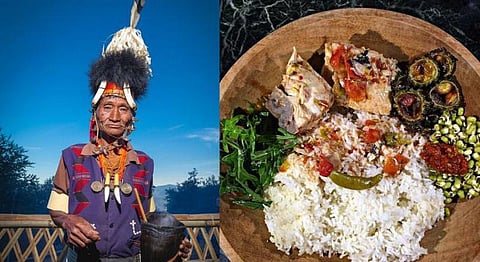
- HOMEGROWN WORLD
- #HGCREATORS
- #HGEXPLORE
- #HGVOICES
- #HGSHOP
- CAREERS
- ABOUT US
- CONTACT US

Nagaland, one of the seven sister states of Northeast India is a land where there are 16 main tribes, each with its unique traditions, practices and culinary habits. So, you can imagine, there ought to be more varieties in the Naga kitchen than one can handle. However, there are not too many places or restaurants all over the country, or even in Nagaland itself, which serves Naga food. The ingredients are so authentic and rare to come by, and the process of cooking so delicate, that the only place where you can get Naga food is at someone’s home.
So, until you happen to find a kind soul to feed you Naga food yet, here’s a list for you to stare at:
I. Akibiye
This recipe is a staple of the mountainous regions of Nagaland and is mostly enjoyed by the Sema community of the state. It comprises mustard leaves and colocasia roots, and is cooked with very little salt and no spices, thereby giving it a bland flavour. The colocasia root is undoubtedly the main ingredient in the recipe, which also lends the dish its piquancy. Very little water is used in the recipe, since it is mostly preferred thick. Akibiye is best had with a bowl of steamed rice.
II. Awushi Kulho
This is a zero-oil Naga chicken stew made with minimal spices and seasonal green vegetables, making it an immensely healthy choice for people aiming for a clean diet. It traces its origins to the Ao tribe of Nagaland and is kind of easy to make.
III. Akini Chokibo
One of the famous dishes of Nagaland, Akini Chokibo is an expensive delicacy of the state. Chokibo means snails and akini refers to perilla seeds which are a type of herb belonging to the mint family. Sometimes pork or akhuni is also added to the dish.
IV. Smoked pork in akhuni
One of Nagaland’s most savoured delicacies, ‘akhuni’ is prepared round the year by all tribes. It is fermented in a semi-coarse soya bean paste, and has a bitter, smoked taste to it. Mostly, ‘axone’ is used along with vegetables to make a stew. As much an ingredient, ‘axone’ also doubles as a condiment and is used to make pickles, chutneys and curries. Best paired with smoked pork, it’s often used along with vegetables to prepare stews.
V. Hinkejvu
Hinkejvu is made with colocasia, shredded cabbage leaves, mustard leaves and some French beans. All of them are boiled to bring out the flavour and just a pinch of salt is added for taste. This dish is something that most Naga households would enjoy as part of their daily meal.
VI. Amrusu
Amrusu is the signature dish of the Ao tribe and is made from ground rice, chicken, and bamboo shoots. Flavoured with green chillies, ginger and garlic, it is generally consumed as comfort food and is extremely filling.
VII. Galho
Galho is a soupy concoction made from rice, vegetables or meat and is the Naga version of khichdi. It is cooked with seasonal vegetables along with pieces of pork fat or smoked pork. The vegetarian version of Galho is prepared using vegetables and garnished with ginger.
IX. Zutho
Zutho is a fermented drink obtained from rice. It has a fruity aroma and sour taste, similar to those of Japanese sake and sprouted rice sake. is a combination of five essential things–rice, water, yeast, an undisturbed spot for fermentation and patience. You mess up with any one of these and you won’t have a good rice beer. The drink has been popularised by the Hornbill Festival of Nagaland.
If you enjoyed reading this article, we suggest you also read:
